Treatment
The information below is the result of observations and experiences of the ZARD community. Due to limited research on symptom management and treatment guidelines, the Foundation hopes to bring value by highlighting this anecdotal evidence along with symptoms noted in clinical research. For published research please click here.
All medical treatment plans, including risks and benefits, should be thoroughly discussed with the patient’s medical team as each patient is unique.
If you are a parent and/ or patient affected with ZARD and wish to share your own observations and experiences, we encourage you to contact us at connect@zc4h2foundation.org.
Symptom management and clinical treatment of ZARD may involve the following medical specialties:
The primary care provider coordinates multispecialty care for the patient along with chronic and acute health management. The pediatrician is essential especially during early childhood development when consults to specialists are initiated. Many families agree the first couple of years are the most challenging due to navigating all the specialists and consults required for our medically complex patients.
Many patients are born with contractures at birth often diagnosed as arthrogryposis. Patients are also followed for feet deformities, hip dysplasia, and scoliosis. Most children with ZARD will need one or more orthopedic surgical interventions, the most common being feet and knee corrections, spinal surgery, and hip surgery.
An important observation from our community is the worsening of range of motion after surgery. This may point to the impaired remodeling/healing of soft tissue in our condition. As we do not yet understand the physiology of muscle and soft tissue in ZARD patients, we strongly recommend discussing invasive surgical interventions at length, seeking second opinions, and whenever possible and safe, considering conservative approaches such as serial casting, bracing and therapy.
Further research to the physiology and function of muscles from ZARD patients will hopefully offer further insights.
The surgical outcomes from spinal fusions including growth rods have been largely positive. Hip surgeries have mixed outcomes, so a patient centered approach as it relates to quality of life is best. Patients have often noted concerns with surgical outcomes regarding knee contractures. Serial casting, bracing, and physiotherapy have shown to give positive results generally. Serial casting is best when done in early childhood. Ponseti method for clubfoot correction has been a best practice in our patients.
It is important to note that some patients can have diagnosed spasticity. These patients generally respond well to Botox and phenol injections.
Most patients benefit from custom orthopedic bracing including AFOs, wrist splints, and in some cases KAFOs and HKAFOs.
ZARD patients, like many AMC patients, seem to have a predisposition to respiratory problems postoperatively.
All patients with ZARD are officially diagnosed through genetic testing. Worldwide, the diagnostic testing protocols vary greatly. Some newly diagnosed patients’ families have experienced frustration with lack of information about ZARD. This is very common and the Foundation is working diligently to help geneticists empower their patients with up to date and relevant information. Appropriate genetic counseling is crucial, especially in the early stages after diagnosis.
Current published research can be found here
Neuromuscular symptoms are a characteristic in many patients. This can include spasticity, dystonia, apraxia, and neuropathic pain. Many patients, depending on their presentation, may benefit from drugs such as baclofen or gabapentin. Some patients have reported issues with autonomic nervous system dysfunction including flushing. Some patients have been diagnosed with epilepsy. Your neurologist should recommend the most appropriate approach to monitoring any possible abnormal activity. For more complex cases it may be helpful to consult an epileptologist.
Brain MRIs have not been a strong indicator for neurological impairment in our community since brain structure in the majority of patients appears normal or with certain variations of undetermined significance.
Breathing issues are not uncommon with ZARD patients especially at birth. Fortunately, many patients outgrow these challenges. Some patients have been treated successfully for aspiration pneumonia through (prophylactic) use of antibiotics for example, azithromycin. Patients have benefited from nebulizers, chest percussion therapy, postural drainage, and supplemental oxygen. Some patients require a gastric tube and fundoplication due to aspiration while swallowing. In rare cases patients benefit from tracheotomies. Medical treatment during respiratory illness is strongly encouraged to prevent possible complications.
In most cases, especially the first year of life, timely and periodical swallow studies have been necessary to determine the appropriate protocol for management of aspiration pneumonia in ZARD children.
Pneumonia in ZARD is often a secondary infection. The primary issue in ZARD is motor planning impairment, which affects the coordination of breathing and swallowing. This leads to micro and macro aspirations, increasing the risk of respiratory complications. During seasonal viral infections, postnasal drip worsens due to excess mucus and fluids in the throat, further impairing swallowing and breathing coordination. This in turn increases aspiration, which can result in secondary bacterial lung infections. However, children with ZARD typically do not have compromised immune systems or excessive saliva production.
Key Recommendations: 1. Recognize the root cause: Respiratory issues in ZARD stem from aspiration caused by motor planning deficits. 2. Interventions: • Preverbal speech and feeding therapy with specialists in oral motor therapy or apraxia to improve safe swallowing. • Long-term prophylactic azithromycin • RSV vaccination: as RSV increases secretions for prolonged periods, and therefore the risks of aspiration, it often leads to bacterial pneumonia in ZARD. (Our knowledge and community experience is limited to the antibody-type vaccines for RSV. For other type of RSV vaccines, please discuss with the treating physician).
Understanding these factors can help doctors and caregivers prevent and manage pneumonia effectively.
Physical Therapy, including early intervention, is one of the crucial supportive approaches for ZARD. Some young patients in early intervention (0-3 years) have seen success with a neuro development approach to physical therapy. Usually, this approach focuses on minimizing reflexes or integrating them into functional movement. Some patients report spasticity categorized as mixed muscle tone combined with motor apraxia. Tight abductors and hamstrings as well as muscle atrophy has been reported in many patients.
The Foundation encourages PTs to take a patient centered approach and focus on independent mobility as opposed to walking when appropriate. Massage that focuses on neurological pathways can be very helpful. Tummy time is challenging for many patients, and using an exercise ball is a great way to strengthen the upper body when tummy time on a mat is too challenging for child. Caution should be taken with our children during range of movement. Some patients have reported fractures so extra caution should be taken.
Occupational Therapy is important to support the achievement and conservation of functions that pertain the day-to-day deployment of activities in children and patients with ZARD. Some of our children present with hand and finger deformities and benefit from splinting of the hands. Some fingers have “symphalangia,” meaning the finger joints are not there, or other problems of the finger joints, which can be challenging when working on fine motor skills. Motor apraxia and spasticity is especially challenging for many patients.
Children and patients with ZARD are affected very differently in their ability to communicate verbally. Impairment in the motor planning -a common characteristic among ZARD patients- could be an important factor for speech difficulties often seen in our children.
Many ZARD patients are diagnosed with oral and/or verbal apraxia, which is an oral motor disorder affecting verbalization. Speech and language therapy focusing on oral motor planning impairments such as apraxia of speech, have shown excellent outcomes in speech production and speech improvement among our children. Early intervention in speech and language therapy utilizing oral motor techniques is recommended.
The Foundation strongly advocates for every patient with ZC4H2 to have a voice in their life. The form that takes will differ based on individual abilities. Some children with challenging verbal communication could benefit more from augmentative communication devices. Many children with ZARD can speak verbally (with or without difficulties) but may need extra time to communicate.
In the first few years of life, many children with ZARD also struggle with oral feeding or have difficulties coordinating breathing and swallowing, either by anatomical malformations (such as laryngomalacia or cleft palate) or by impairment in the oral motor planning. This can lead to (recurrent) aspiration pneumonia. Some outgrow those challenges and learn to speak as well as eat and drink by mouth. Others benefit from gastric tubes for nutrition and may taste foods for pleasure as opposed to full nutrition. A swallow study is often helpful prior to feeding patients when concern is warranted based on medical history. The goal should be overall wellness of the child in terms of nutrition so an individual approach is recommended based on ability. Early intervention in pre-verbal and feeding therapies is recommended.
Some patients have been diagnosed with cortical visual impairment, a visual/ neurological processing issue, and/ or ocular apraxia, including Duane syndrome. Issues with the physical structure of the eye are limited, but a few patients have been diagnosed with ptosis, strabismus, exotropia and/ or underdeveloped ocular nerve.
Feeding and breathing issues seen in our children, especially in the early years, may have diverse reasons; either anatomical malformations (such as laryngomalacia and jaw deformities) or neurological causes like the broadly reported difficulties to coordinate breathing and swallowing at the same time, which may be a consequence of motor planning impairments. Other symptoms as apnea and Eustachian tube disfunctions have been reported too.
All patients with ZARD should be screened for tethered cord through MRI. Multiple patients have been diagnosed with tethered cord over the last years. Before surgery involving the spine including fusions or baclofen pumps, tethered cord should be thoroughly ruled out to prevent long term complications. Occult tethered cords have also been reported. MRI should be performed at a children’s hospital that routinely performs untethering procedures for most accurate results. Tethered cord surgeries have been successful and life changing in some patients.
A few patients, mainly males, have cardiac heart defects and/or heart rhythm disturbances.
Some patients have experienced issues with blood sugar levels. Hypoglycemia or other abnormal glycemic responses have been reported.
Most children can be overweight and have big appetites. We don’t really know the endocrinologic reason behind it although there are indications of insulin resistance in some children. Some patients present premature adrenarche and/or early puberty. Patients in many cases have shown improvements with diet modification including a diet based in restricted calories and carbohydrates. A regimented or continuous feeding schedule has been helpful and a few children have needed medicine to control hyperinsulinemia.
Some patients, especially those suffering from spasticity and discomfort, have benefited from phenol injections and Botox. Phenol injections are directed at the nerve as opposed to the muscle like more commonly used Botox. Phenol injections are performed under anesthesia usually by a physiatrist or orthopedic surgeon. Cases of baclofen pump trial are very limited at this time, but tethered cord should be thoroughly ruled out before attempting pump.
The Foundation strongly encourages all surgeries to be completed at a reputable children’s hospital with a pediatric anesthesiologist experienced with complex cases. ZARD patients can have issues with breathing and heart rate during procedures which is routinely treated with proper care and precautions. Patients should be monitored closely in the pediatric intensive care unit due to breathing complications after anesthesia. Some patients have remained intubated longer than usual for the safety of the patient’s airways. Some patients have shown sensitivity to medications that suppress the respiratory system (such as opioids) and should be well monitored.
Many ZARD patients have difficulties for venipuncture, with veins difficult to localize. In some cases, access for intubation has been reported to be challenging.
The orpha.net publication, Anesthesia recommendations for patients suffering from Arthrogryposis multiplex congenita – June 2011 (orpha.net) has been helpful to both patients and providers. The foundation encourages its distribution to the surgical team before any procedure especially time-intensive surgeries.
Some ZARD patients require gastric tubes for nutrition. Fundoplications are also common in these patients to prevent reflux. Constipation is extremely common in our patients which is usually treated with stool softeners or typical treatments. Physical activity is also beneficial for constipation including rolling, range of motion, and especially standing. Change in diet can help with constipation but is often not enough. Constipation is especially challenging after surgery.
Limited verbal communication, communication delays, fixation on certain activities and objects, and motor planning issues have been reported. Autism has been diagnosed in patients with ZARD. Additional research is needed to form a more accurate picture of these behavioral differences in the ZARD community. Cognitive evaluations are often inconclusive because the standard tests require motor planning and mobility to respond. Many of our children are in general education classes with individual supports as needed. The Foundation encourages inclusion in the school setting.
Wheelchairs, standers including mobile standers, and/ or gait trainers are utilized by ZARD patients. Mobility independence is important for all children including ZARD patients. Some patients love their adaptive bikes, which can help with range of motion and prevent further contractures, but should be used in caution with patients susceptible to fractures. All terrain wheelchairs, beach wheelchairs, adaptive sleds, and jogging strollers are mobility devices that encourage inclusion and bring joy to our loved ones with ZC4H2 Associated Rare Disorders.
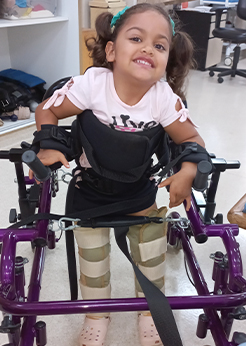
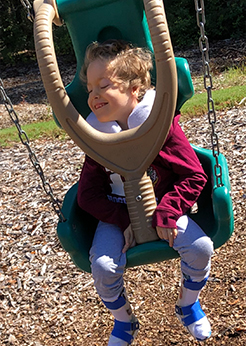
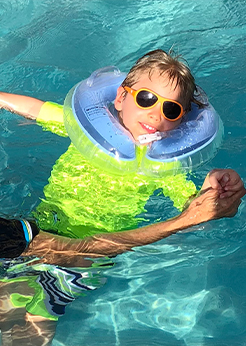
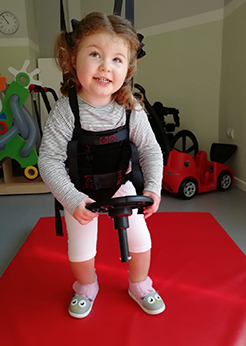
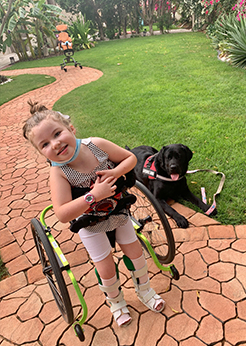
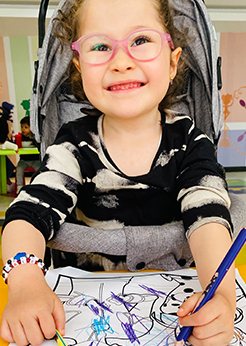
ZC4H2 Research Foundation, Inc. All rights reserved.
ZC4H2 Research Foundation has been recognized by the Internal Revenue Service as a 501(c)(3) organization. EIN: 87-4577599




